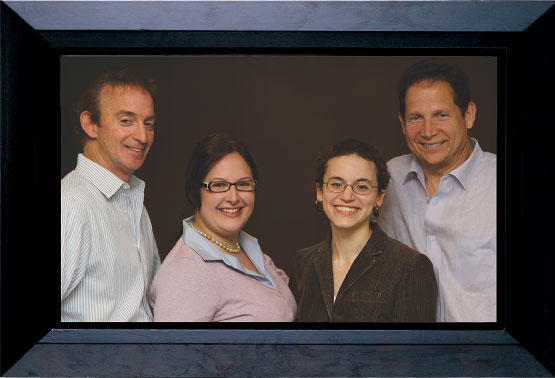A Big Leap toward Gender Equality
When a major pharmaceutical company discriminated against women in its workforce, a civil rights law firm stocked with Vassar grads stepped in to seek justice and help close the lingering gender gap. The class-action lawsuit resulted in a landmark verdict and the largest ever award in a U.S. gender discrimination case.

The testimony delivered from the witness stand of the United States District Court, Southern District of New York, shocked nearly all who heard it. The case was Velez et al. v. Novartis Pharmaceuticals Corporation, a class-action gender discrimination lawsuit brought against the U.S. arm of the Basel, Switzerland-based pharmaceutical behemoth. At issue was whether Novartis violated the Civil Rights Act of 1964 and the Pregnancy Discrimination Act of 1978.
A succession of a dozen women related—often in graphic detail—story after story of sexual harassment, a manifestation of an antifemale corporate culture at Novartis that resulted in pervasive gender discrimination.
The litany was astounding. Female sales representatives being groped, inappropriately kissed, or invited to sit on the laps of Novartis-paid doctors. Propositions for sex. Getting passed over for promotions, while younger less experienced male employees moved up the corporate ranks. Pay disparity. Pregnant women on the eve of maternity leave being called into an office and unexpectedly fired. Lewd comments and blatant objectification of the female body.
In some of the most emotional testimony of the six-week trial, former Novartis sales representative Marjorie Salame testified that a doctor at a Novartis-hosted event had raped her. The sum total of the company’s response was to reprimand Salame, the victim, for not being more responsible, and to threaten her with disciplinary action.
The story of the trial began years before, in 2003, when a single woman—Amy Velez, a former Novartis sales rep who’d been with the company for seven years—walked into the offices of the prominent civil rights law firm, Sanford, Wittels & Heisler (SWH), which had a strong track record for dealing with pay and promotion discrimination, sexual harassment, and other public interest law.
Two of the firm’s three founding partners are Vassar grads—David Sanford and Steven Wittels, both from the class of 1980. The men both coincidentally transferred to Vassar from Rutgers University, though they hadn’t known each other in New Jersey. At Vassar they became quick friends, and both interned at the Public Defender Service for the District of Columbia in 1978.
Upon graduation from Vassar they went their separate ways, but after attending rival law schools (Sanford at Stanford and Wittels at the University of California, Berkeley) both found their way into class-action civil rights work. They teamed up on a case around the turn of the millennium, and decid- ed it was time to work together. With a third partner, Jeremy Heisler, they formed SWH in January 2004. It has since grown into a team of more than 25 lawyers, many of them women.

For SWH, class-action suits such as the Novartis case are a mechanism for societal change. “Through the class-action vehicle,” Sanford says, “we’re able to achieve not only monetary relief for individuals, but also extensive systemic change.” That change makes a difference, he says, not just for people named in the suit who are provided financial relief from the wrongs of their current or former employer, but also for count- less others who are still working there, or who will in the future.
It’s risky business. Cases are time-consuming and taken on a contingency basis. What’s more, “to be successful, a plaintiff has to win every battle,” Sanford explains. “Class certification. Motion to dismiss. Win at trial. Win on appeal. The defense only has to win one of those battles.”
As a result, SWH vets cases carefully, rejecting some 95 percent of potential clients. “You never know how a case will evolve,” Sanford says. “You follow the evidence. Sometimes it builds in incredible ways, with supporting overlapping testimony from scores of people.” So it was with the Novartis suit, which included a class of 5,600 women that later expanded to more than 6,000.
Kate Kimpel ’00, a partner at SWH, served as co-lead counsel. She began her professional life as a fourth grade teacher. “I went into Teach for America to further civil rights in this country,” she explains. “Public school classrooms in high-need areas seemed to be the front lines of that battle.” Eventually, though, she “wanted to affect things on a broader scale beyond the reach of one classroom.” And so she became a civil rights lawyer.
For Kimpel, the Novartis case was personal. Her self-described “strong feminist perspective”—a result, she says, of her formative years at Vassar—imbued her with “a belief that every person has rights that ought to be recognized and respected, and a recognition that women have been systematically marginalized.”
She describes a powerful combination of the familiar glass ceiling and what she calls the “maternal wall,” a one-two punch of gender and pregnancy discrimination “coming together to box women in.”
Kimpel found a young kindred spirit in Sarah Siegel ’08. Siegel, who recently finished her first year of law school at New York University, spent two years working at SWH through the firm’s cultivation program for recent college grads pursuing a career in civil rights law. “I wanted to do public interest work,” Siegel says, “but nothing called out to me until I took an internship at a state agency that dealt with anti-gender-discrimination law.”
Suddenly, at SWH, she found herself neck deep in one of the most high-profile gender discrimination cases in the country. Siegel was tasked with organizing, cataloging, and prioritizing 3.7 million pages of documentation. “One thing a good Vassar education gives you,” the history major says, “is the ability to recognize and organize facts relevant to any given claim, to see what’s important in any situation.”
What was most important was seeing justice served in the Novartis case. The outcome largely came down to numbers. Proving workplace gender discrimination is a matter of statistics. Leadership positions held. Promotions offered or denied. Wage and salary disparities. “Gender bias is evidenced in the analysis of hard data,” Sanford says. “Ultimately, we’re either right or wrong.”
At Novartis, the data was damning. In May 2010 the jury declared the company liable and stipulated $253 million in damages, the largest award for a gender discrimination case in United States history. Rather than appeal, Novartis agreed to a $175 million settlement, officially approved in November. Judge Colleen McMahon, who presided over the lengthy litigation, described SWH as trying the case “brilliantly” and said the firm had achieved “extraordinary” and “one of a kind” results.
The Novartis suit remains a landmark case in the United States, especially in light of Dukes v. Wal-Mart Stores. Kimpel co-authored an amicus brief for the case on behalf of the U.S. Women’s Chamber of Commerce. Representing some 1.6 million women, it would have been the largest certified class ever. However, in late June, the U.S. Supreme Court struck down the class certification, effectively ending the discrimination litigation in its present form.
Clearly, the landscape of gender equality in the American workplace is changing, as it has been for more than half a century.
Miriam Cohen, a professor of history with an interest in the history of American women and 20th-century social reform, points to AMC’s 1960s era Mad Men television show as a starting point to look back. “The women are overeducated for the positions they hold,” Cohen says. “They have a good education, they’re talented, and they want to do something beyond the ‘standard, acceptable’ professions.” It was an era, Cohen notes, when women were high school teachers, not professors; editorial assistants, not editors; secretaries, not managers. “That kind of disparity becomes increasingly less viable,” she says, “especially as more and more women are educated.”
“What’s also different now is that women are getting married, or having a male or female partner, raising families, while also pursuing long-term careers,” Cohen says. “Pregnancy doesn’t mean leaving quietly and not coming back.” In other words, today it’s about breaking down the glass ceiling and maternal wall described by Kimpel. As those boundaries weaken and come down, “it’s impossible to go back to old thinking,” Cohen explains.
With more educated women graduating from college, as more become the primary or co-breadwinner, as more men stay home with the kids, as more couples share the child care role, and as parents age and require elder care from their working children, a new playing field is taking shape, one in which “the fundamental challenge is how our entire society balances family, work, and care-giving,” says Cohen.
Yet, as that landscape changes, women still find themselves disproportionately the subjects of discrimination. Sanford, Wittels, and Cohen all point to the same factors: predominantly white men in senior management and executive positions, in the board rooms, in positions of decision making and power. “Without women having effective representation ... when you have a male corporate culture, it’s not going to be as sensitive or responsive to women’s rights,” Wittels says. “Inequities then perpetuate.”
Women in America: Indicators of Economic and Social Well-Being, a report published in March by the White House, offers a window into this shifting landscape—and the perpetuating inequity. Across all earners, women’s earnings are only 75 percent of their male counterparts.
Some change has undoubtedly been positive, however. Between 1950 and 1999, the number of women in the workplace doubled. More women have been earning college degrees and attaining higher-level professional positions. Among full-time earners, women’s weekly income as a percent of men’s increased from 62 percent in 1979 to 80 percent in 2009. And among the youngest generation of workers, ages 25-34, women’s earnings were 89 percent of their male counterparts’ in 2009.
The report offers signs of the changing times, showing high percentages of working mothers in recent years, and that 57 percent of married couples are dual-earner families.
Change has been slow to come, and there is more change yet to come, but progress has been made and continues to be made, championed by women and men who believe in equality.
Such progress toward a more equal American workplace happens “through public policy changes,” says Cohen, “and in the United States, through a history of forcing change through the legal system.” Which is where Sanford, Wittels, Kimpel, and Siegel come in.
“Case by case, we take on corporate America on behalf of individuals who are trying to level the playing field,” Sanford says. “Our hope is that through our work, and the attention given to it, there will be noticeable change.”
